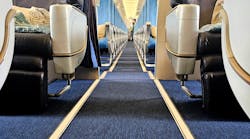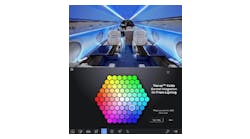Sterling Heights, Michigan USA March 31, 2015 – Representatives of Aviation Occupant Safety, LLC (AOS) announced today that one of its parent companies, Key Safety Systems (KSS), has received a U.S. Patent (8,939,465 B2) for “Safety Restraint Protection for Aircraft Occupants Seated Facing the Side of the Aircraft.”
The patented inflatable, monument mounted device(s) are used in business and general aviation aircraft cabin applications where passengers are seated facing perpendicular to the aircraft’s cabin to protect the passengers’ head and torso areas from lateral movement, while further mitigating lateral injury from leg flail.
Tony Nardone, KSS President of Specialty Division and AOS Director explained that these new units were developed in compliance with FAA Policy PS-ANM-25-03.
“At KSS we pride ourselves on the ingenuity of our design and engineering teams that find innovative ways to create modern technology products that make travel safer,” he said. “This patent award demonstrates our commitment to continually improving aircraft occupant safety.
“These new passenger restraint units will dramatically reduce lateral movement, while absorbing impact forces from adjacent passenger-to-passenger and passenger-to-cabin structure surfaces,” Nardone said. “These units are already in use aboard a popular mid-size aircraft and now that we have received the patent we can continue selling it to other aircraft manufacturers knowing the technology is accepted and proven.”
“This new technology provides a level of passenger impact safety that has never been available before,” stated David Devine, Director of AOS. “What truly sets it apart is along with the side- and center-located active inflatable side-facing passenger restraint system, (similar to the side airbags on a car), the system features a proprietary system that minimizes the occurrence of injuries from ‘leg flail.’
“Leg flail is a situation where passengers seated laterally can suffer serious injuries because their legs are unrestrained during impacts,” he added. “Our leg flail restraints have proven during tests to greatly minimize occurrences of these types of injuries.”
Devine also explained that during the new system’s development, the engineers worked hard to make sure the location and appearance of the inflating systems would blend into the aircraft’s cabin.
“They are designed to provide maximum occupant safety with minimal impact on the interior’s aesthetics,” he said.
About AOS.
AOS is a joint venture between two global safety restraint industry leaders: Aircraft Belts, Inc., (ABI) and Key Safety Systems (KSS). www.aviationoccupantsafety.com



